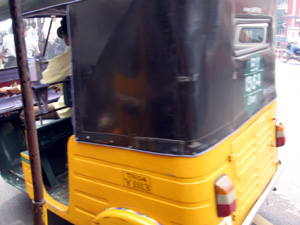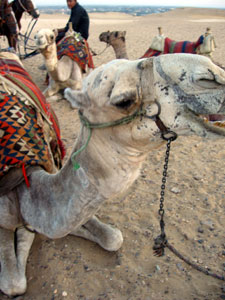TABLE
OF CONTENTS
|
Reckless
Rickshaws
By Suzanne Schefcik
The
transit system of India
was much like the country: a land
of contrasts. India
has no cultural boundaries or a defined transit system. Cows, cars,
camels,
horses, rickshaws, buses and trains are all used to transport people
and goods
from place to place. The spontaneity of India’s public
transportation
system replicates many different aspects within the country.
The train
system throughout the country remains a feasible way to maneuver around
India.
First,
second and third class cars are available to those who can afford it.
My public
transportation experience to New
Delhi
took place in a third class train. There was no AC or fans. The heat
was deadly;
however, the cultural experience I gained was
unmatched. The train was lined
with locals and children who all wanted to meet the white Americans. We
talked about
their schooling and played games with the natives. It was interesting
to see
them in their own cultural realm. gained was
unmatched. The train was lined
with locals and children who all wanted to meet the white Americans. We
talked about
their schooling and played games with the natives. It was interesting
to see
them in their own cultural realm.
Rickshaws
were abundant throughout India.
These small, yet fast, little cars bumped and rolled along the streets
carrying
passengers for small amounts of money. As I rode through the various
cities in India,
I felt as though there were no rules on these vehicles. Drivers pulled
over
whenever they felt like it to bring you to their buddies’ storefront,
prices
were negotiable, and one way streets seemed to be optional. Most
drivers I
encountered knew little or no English, indicating they had little
schooling.
Usually, they gave me the head wiggle and I hoped I was headed in the
right
direction.
In
correlation with the article written by Sudharak Owle, “Not
a pretty
picture,”
the rickshaw drivers live impoverished lives, like street sweepers. The
conditions in which these drivers work are not the best. Along with
this, they
do not make an ideal amount of money for the amount of work that they
do. Hours
can be long and strenuous. Passengers can be rambunctious, rude and
cheap. The
lifestyle of a rickshaw driver can be very demanding. Unfortunately,
drivers
receive little recognition.
 Along
with
rickshaws covering the streets, animals roam around freely. Camels,
cows, dogs
and chickens can be seen aimlessly making their way around the cities.
Many animals
are used as transportation among the people. Camels can be seen
carrying people
to various destinations, while horses pull heavy loads to others.
Personally, I
thought that this crazy mixed variety of transport worked well within
the society.
People obviously came from all different castes and economic
backgrounds. The different
modes of transport available seemed to meet the needs of the
contrasting
groups. Along
with
rickshaws covering the streets, animals roam around freely. Camels,
cows, dogs
and chickens can be seen aimlessly making their way around the cities.
Many animals
are used as transportation among the people. Camels can be seen
carrying people
to various destinations, while horses pull heavy loads to others.
Personally, I
thought that this crazy mixed variety of transport worked well within
the society.
People obviously came from all different castes and economic
backgrounds. The different
modes of transport available seemed to meet the needs of the
contrasting
groups.
The bus
system in India
seemed just as hectic as the rickshaws. An over abundant number of
people were crammed
into small buses to reach their destinations. Obviously, the number of
buses
fell below the necessary amount needed in order to comfortably fit the
number
of people. The over-crowdedness of India was apparent in nearly all aspects
of the society. Not only buses, but cars, carts and trains were filled
to the
brim. The government evidently has a hard time instating mass transit
that
meets the needs of the expanding population.
The
spontaneity of India’s
transportation reflects the mayhem and disorganization within the
country. The
caste system enables India
to maintain a vast range of transport modes. Cost efficient vehicles
and
animals are necessary for lower castes, whereas higher prices and
efficient
means of transport are necessary for higher castes. India,
the land of contrasts, seems
to have no defined transit system that can be captured in one single
description. Transit employees who must cope with the harsh terms and
low pay
where they work hopefully will gain respect and wages need to live
comfortably.
|

gained was
unmatched. The train was lined
with locals and children who all wanted to meet the white Americans. We
talked about
their schooling and played games with the natives. It was interesting
to see
them in their own cultural realm.
Along
with
rickshaws covering the streets, animals roam around freely. Camels,
cows, dogs
and chickens can be seen aimlessly making their way around the cities.
Many animals
are used as transportation among the people. Camels can be seen
carrying people
to various destinations, while horses pull heavy loads to others.
Personally, I
thought that this crazy mixed variety of transport worked well within
the society.
People obviously came from all different castes and economic
backgrounds. The different
modes of transport available seemed to meet the needs of the
contrasting
groups.